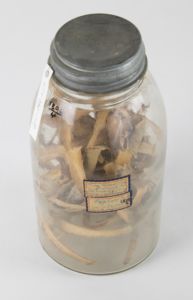
June 19, 2017
The Minnesota frontier could be a frightening place to have an illness by today’s standards. Travel was slow, medical education was unregulated, and medicines were often limited to what you could make with the plants at hand. Many of these medicines that early white colonists in Minnesota used were remedies that had been learned from Native Americans, some of which were described in detail in “Home Remedies of the Frontier,” written in 1949:
The Chippewas learned that the pitch of the balsam fir would help a headache. The umbrella plant was applied as a poultice for a sprain, and wild sarsaparilla was good for the blood. […] Wild ginger was good for a pain in the stomach and the fern helped to relieve insect bites, of which there were many.
Some of these early medicines, including our object of the week, are part of the Hennepin History Museum collection. This particular photograph shows a two quart jar with strips of poplar bark, used as a medication for ulcers. The instructions on the jar read, “Steep a few pieces and drink in the morning before anything.” Another medicine acquired was a jar of quassia bark, used by the donor’s mother to create a “bitter concoction,” which her children dipped their fingers into to discourage nail biting.
In the early days of American pharmaceutical companies, these plant-based medicines were quickly capitalized, and rather than the long process of research and testing required for medicines to reach the market today, Madison writes that “unproved claims for efficacy provided the means of enticing consumers to buy the product.” The very first Minnesota newspaper devoted over three columns to drug and medical advertisements, and “there was no lack of enthusiasm in the claims for what a bottle or a pill would do.” (Home Remedies).
As the pharmaceutical industry blossomed, regulations became tighter and many of plant-based medicines, whose benefits could not be scientifically proven, were considered obsolete. Today, Hennepin History Museum is home to some of these old remedies, remnants of a bygone era on the Minnesota frontier.
Author Caitlin Crowley graduated this spring with a BA in history and a minor in medieval studies from Augsburg College. This fall she will be attending the University of Minnesota for a masters in Heritage Studies and Public History.
Resources
“Home Remedies of the Frontier,” The Saint Louis Park Dispatch, July 8, 1949, Medicine: MN: First Doctors and Early History Folder at Hennepin History Museum.
James H. Madison, “Eli Lilly: A Life, 1885-1977,” Indianapolis: Indiana Historical Society Press, 2006.
“Patient Was Classroom Before 1893: Medics Were Once a ‘Rough Lot’,” Minneapolis Star, November 2, 1965.
“The Sick on the Frontier,” The Hennepin County Review, June 9, 1949, Medicine: MN: First Doctors and Early History Folder at Hennepin History Museum.
